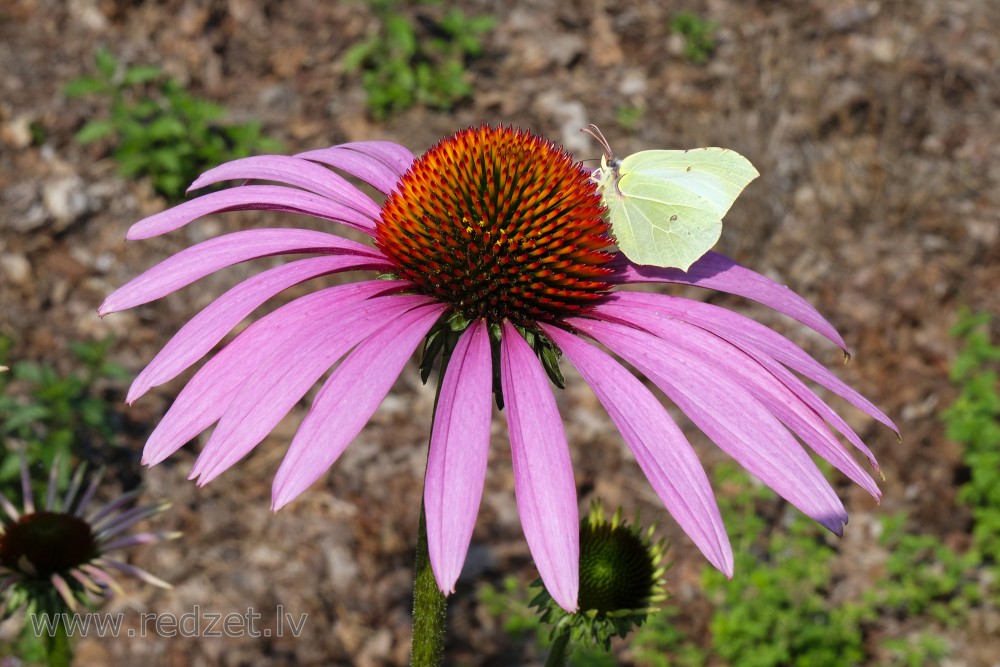Common Brimstone (Gonepteryx rhamni)
Gonepteryx rhamni (known as the common brimstone) is a butterfly of the family Pieridae. It lives throughout the Palearctic zone and is commonly found across Europe, Asia, and North Africa.Across much of its range, it is the only species of its genus, and is therefore simply known locally as the brimstone.
The brimstone relies on two species of buckthorn plants as host plants for its larvae; this influences its geographic range and distribution, as these plants are commonly found in wetlands.The adult brimstone travels to woodland areas to spend seven months overwintering. In spring when their host plants have developed, they return to the wetlands to breed and lay eggs.Both the larval and adult forms of the common brimstone have protective coloration and behaviour that decreases their chances of being recognised and subsequently preyed upon.
The adult common brimstone has sexual dimorphism in its wing coloration: males have yellow wings and iridescence while females have greenish-white wings and are not iridescent. This iridescence is affected by environmental factors.
Distribution and habitat
The common brimstone can be commonly found throughout the Palearctic. Individuals have been seen from western Europe to east Asia. The high mobility of this butterfly allows it to search widely for new host plant locations and expand its range.While the geographic distribution of the adult is larger than that of its host plant, its range is nevertheless limited by its the presence of host plants due to the needs of its larval stage.
The common brimstone uses various environments for different stages of its life cycle. The butterfly inhabits wetlands during mating and breeding season, as they provide ideal areas for oviposition due to an abundance of host plants like the alder buckthorn.The common brimstone prefers laying eggs on younger host plants with late bud-bursts that are isolated from other plants in the area and exposed to both open space and sun.During the winter, adult brimstones travel to woodlands to hibernate, as they provide ideal overwintering sites with shelters such as evergreen foliage and holly.The common brimstone has an appearance that is highly similar to the leaves of these plants, so during hibernation it can remain hidden.In other seasons, habitat selection is also affected by the abundance of nectar as a food source for adult brimstones.
Food resources
Caterpillar
Larval brimstones appear to only feed on two plant sources: the alder buckthorn (Rhamnus frangula) and the common buckthorn (Rhamnus carthartica). This influences the distribution of the adult brimstone, as the presence of these two buckthorn species is necessary for the survival of their offspring.
Adult
Unlike their larval forms, which are specialised for particular host plants, adult brimstones are not specialised nectar feeders. The common brimstone heavily feeds on the nectar of several flowering species: Centaurea jacea, Knautia arvensis and Succisa pratensis. However, brimstones have also been observed feeding on the nectar of Tussilago farfara in April and May and have been recorded gathering nectar from many other species of flowers. Adult food plant availability is another factor that is important for habitat selection.
Life cycle
The common brimstone is one of the longest-living butterflies, with a life expectancy ranging from 10 months to a year.Due to its hibernation and life cycle, it has one generation per year. Development from the laid egg to the emergence of the imago is approximately 50 days.However, the adult brimstone spends a large portion of its life in an overwintering state. The brimstone is highly mobile, feeding and travelling to regions ideal for hibernation during the late summer and fall, and returning to regions ideal for mating and egg-laying during the spring.
Egg
Adult common brimstones lay eggs singly on the underside of buckthorn leaves. The eggs are around 1.3 mm tall, and are spindle-shaped in appearance.The eggs change colour over time, initially having a greenish-white colouration, then progressively darker shades of yellow, and finally brown before hatching.
Caterpillar
The larvae of the common brimstone undergo five instars, initially having a length of 1.7 mm in the first instar and reaching up to 34.9 mm in length when fully grown.The caterpillars have a green colouration with white hairs and dark tubercules across its length.When they first hatch, they move to the top side of the leaves and eat them, leaving characteristic hole patterns in their host plants.During the day, they feed and then rest in the open, lying still on the midrib of leaves, where their colouration makes them difficult to distinguish.
Pupa
Pupation occurs over approximately two weeks. The pupae are 22.2-23.8 mm in length and have the appearance of a curled leaf, with pointed ends and bulges in the middle.The pupae are secured to stems and leaves using silk; a cremastral hook attaches to a silk padding, and a length of silk secures the pupae around its middle.The pupae have a primarily green colouration, but right before adult emergence for males, the wing areas turn yellow.
Adult
Adults emerge during the summer, from June to August, and continue to feed until September.The common brimstone hibernates for the next seven months of winter, remaining inactive until April, where they then emerge and proceed to reproduce and lay eggs.Adult brimstones are highly abundant for several months after their emergence from overwintering. The common brimstone has sexual dichromism, with males having a sulphur yellow wing colouration and females having a greenish-white wing colouration.Additionally, males have iridescent dorsal wings that change in colour and appearance under ultraviolet light, while females do not.Both males and females have orange spots in the discoidal cell of each wing, pink head and antennae, and a thorax covered in white hair.
en.wikipedia.org
https://en.wikipedia.org/wiki/Gonepteryx_rhamni
Continue reading